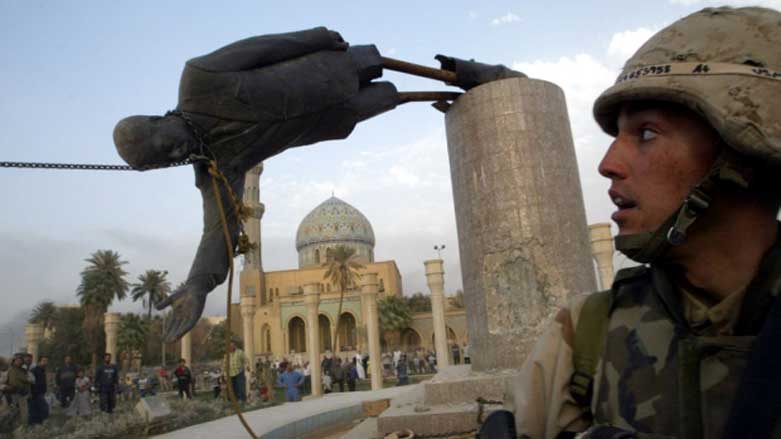Part I: Kurds are right about OIF!

WASHINGTON, United States (Kurdistan24) – The Chilcot report on Britain’s involvement in Operation Iraqi Freedom (OIF) follows others of its genre in concluding that Saddam Hussein destroyed his weapons of mass destruction (WMD) long before Operation Iraqi Freedom (OIF) began, and the war was unnecessary. Kurds in Britain and elsewhere, nonetheless, have affirmed that they believe ousting Saddam was the proper thing to do. They are right.
Those Britons with politically fashionable opinions, like their American counterparts, are mistaken. Knowledgeable officials have explained what most likely happened to Iraq’s WMD: it was moved to Syria before the war.
James Clapper is now America’s top intelligence official: Director of National Intelligence. During OIF, Clapper headed the National Imagery and Mapping Agency, which interprets satellite imagery.
In October 2003, Clapper told journalists that he believed “material from Iraq's illicit weapons program had been transported into Syria” before OIF began, as the New York Times reported.
The Chief of Staff of the Israeli Defense Forces then, Gen. Moshe Yaalon, had the same view.
In 2008, John McLaughlin, former CIA Deputy Director, was asked whether Saddam might have moved WMD to Syria before the war.
McLaughlin replied that the CIA had not had the time to explore that scenario!
The view that Saddam had no WMD comes from the Iraq Survey Group (ISG) Established in the spring of 2003, the ISG was huge—1,200 people, but also deeply flawed. A nuclear inspector who had worked only one year in Iraq, David Kay, was its first head and left his position early. The investigation was far from complete when he resigned. Nonetheless, Kay proclaimed that Saddam had no proscribed weapons.
Charles Duelfer, who was far more qualified, succeeded Kay in early 2004. Several months earlier, Duelfer had complained to me that among the ISG’s large cohort “only five to ten” were “genuine experts.”
Deep knowledge of Saddam’s WMD did not lie with US intelligence. Rather, it resided with UNSCOM, the UN Special Commission, established after the 1991 Gulf War. The UN ceasefire required Iraq to declare its prohibited weapons and turn them over to UNSCOM for supervised destruction.
UNSCOM functioned until December 1998, when Saddam ended its presence in Iraq. Rolf Ekeus, a tough-minded Swedish diplomat, headed UNSCOM until 1997. Duelfer was his deputy.
In 2007, Ekeus complained to me that “very few” ISG personnel were “competent.” Duelfer realized this Ekeus said, but “didn't go to the mat and protest that he couldn't do his job properly without better people.”
During Bill Clinton’s presidency, the US did not consider Saddam a major threat. Intelligence collection on Iraq’s weapons programs was a low priority. Thus, US personnel were not well-informed about them. Nonetheless, in 2003, they were keen to join the ISG. They assumed that finding Saddam’s WMD would be easy and wanted the credit. The ISG, however, excluded UNSCOM personnel despite their more extensive knowledge.
Moreover, experts, such as they existed within US agencies, did not necessarily go to Iraq. Managers often sent themselves, because they wanted the extra overseas and hazard pay.
Dick Spertzel was UNSCOM’s biological weapons expert. After Duelfer became head of the ISG, Spertzel became his deputy. In October 2003, Spertzel complained to me that the ISG was not using UNSCOM’s information. The Iraqis had lied to UNSCOM about their weapons programs, and UNSCOM had unraveled some of those lies. But they were now repeating the same falsehoods. Spertzel worried that ISG personnel did not know enough to recognize that.
In 2006, a year after the ISG report appeared, Spertzel learned that several hundred 155mm artillery shells filled with sarin had been found buried by a dirt road near the home of a Saddam-era official. They were apparently hidden, just before OIF began. “There cannot be much doubt that WMD were in Iraq, “as OIF began, Spertzel concluded.
Duelfer described a major problem he faced:“the most extreme reluctance” of Iraqi scientists “to speak freely.” Before arriving in Iraq, he thought they would be cooperative, but they feared prosecution for actions under Saddam or retribution from Saddam’s supporters.
Indeed, nine Iraqi scientists interviewed by the ISG were assassinated. Why murder them, if there was nothing to hide? The ISG was repeatedly targeted. Its work in Iraq ended, after a suicide bomber attacked Duelfer’s vehicle in November 2004, killing two guards.
Finally, the explanation that the ISG (and the Chilcot report) offer for Saddam’s dealings with the weapons inspectors makes little sense. The reports take Iraqis at their word, accepting their claim that Saddam pretended to have WMD to scare Iran.
But Iraq maintained that it no longer had proscribed weapons and, therefore, sanctions should be lifted!
The next article will illustrate that and suggest possible answers to a tough question: Why didn’t George W. Bush defend OIF more vigorously?
Laurie Ann Mylroie, Ph.D., taught at Harvard University and the US Naval War College. Most recently, she served as a cultural advisor to the US military in Afghanistan.
Editing by Delovan Barwari
